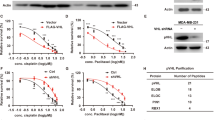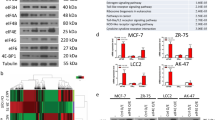Abstract
The oncogenic MUC1 C-terminal subunit (MUC1-C) subunit is aberrantly overexpressed in most human breast cancers by mechanisms that are not well understood. The present studies demonstrate that stimulation of non-malignant MCF-10A cells with epidermal growth factor (EGF) or heregulin (HRG) results in marked upregulation of MUC1-C translation. Growth factor-induced MUC1-C translation was found to be mediated by PI3K→AKT, and not by MEK→ERK1/2, signaling. We also show that activation of the mammalian target of rapamycin complex 1 (mTORC1)→ribosomal protein S6 kinase 1 (S6K1) pathway decreases tumor suppressor programmed cell death protein 4 (PDCD4), an inhibitor of the eIF4A RNA helicase, and contributes to the induction of MUC1-C translation. In concert with these results, treatment of growth factor-stimulated MCF-10A cells with the eIF4A RNA helicase inhibitors, silvestrol and CR-1-31-B, blocked increases in MUC1-C abundance. The functional significance of the increase in MUC1-C translation is supported by the demonstration that MUC1-C, in turn, forms complexes with EGF receptor (EGFR) and promotes EGFR-mediated activation of the PI3K→AKT pathway and the induction of growth. Compared with MCF-10A cells, constitutive overexpression of MUC1-C in breast cancer cells was unaffected by EGF stimulation, but was blocked by inhibiting PI3K→AKT signaling. The overexpression of MUC1-C in breast cancer cells was also inhibited by blocking eIF4A RNA helicase activity with silvestrol and CR-1-31-B. These findings indicate that EGF-induced MUC1-C expression is mediated by the PI3K→AKT pathway and the eIF4A RNA helicase, and that this response promotes EGFR signaling in an autoinductive loop. The findings also indicate that targeting the eIF4A RNA helicase is a novel approach for blocking MUC1-C overexpression in breast cancer cells.
This is a preview of subscription content, access via your institution
Access options
Subscribe to this journal
Receive 50 print issues and online access
$259.00 per year
only $5.18 per issue
Buy this article
- Purchase on Springer Link
- Instant access to full article PDF
Prices may be subject to local taxes which are calculated during checkout








Similar content being viewed by others
Change history
13 April 2021
A Correction to this paper has been published: https://doi.org/10.1038/s41388-021-01727-3
Abbreviations
- MUC1:
-
mucin 1
- MUC1-C:
-
MUC1 C-terminal subunit
- EGF:
-
epidermal growth factor
- HRG:
-
heregulin
- mTORC1:
-
mammalian target of rapamycin complex 1
- S6K1:
-
ribosomal protein S6 kinase 1
- PDCD4:
-
tumor suppressor programmed cell death protein 4.
References
Sonenberg N, Hinnebusch AG . Regulation of translation initiation in eukaryotes: mechanisms and biological targets. Cell 2009; 136: 731–745.
De Benedetti A, Graff JR . eIF-4E expression and its role in malignancies and metastases. Oncogene 2004; 23: 3189–3199.
Wendel HG, Silva RL, Malina A, Mills JR, Zhu H, Ueda T et al. Dissecting eIF4E action in tumorigenesis. Genes Dev 2007; 21: 3232–3237.
Ma XM, Blenis J . Molecular mechanisms of mTOR-mediated translational control. Nat Rev Mol Cell Biol 2009; 10: 307–318.
Dorrello NV, Peschiaroli A, Guardavaccaro D, Colburn NH, Sherman NE, Pagano M . S6K1- and betaTRCP-mediated degradation of PDCD4 promotes protein translation and cell growth. Science 2006; 314: 467–471.
Rogers GW, Komar AA, Merrick WC . eIF4A: the godfather of the DEAD box helicases. Prog Nucleic Acid Res Mol Biol 2002; 72: 307–331.
Blagden SP, Willis AE . The biological and therapeutic relevance of mRNA translation in cancer. Nat Rev Clin Oncol 2011; 8: 280–291.
Bordeleau ME, Robert F, Gerard B, Lindqvist L, Chen SM, Wendel HG et al. Therapeutic suppression of translation initiation modulates chemosensitivity in a mouse lymphoma model. J Clin Invest 2008; 118: 2651–2660.
Lucas DM, Edwards RB, Lozanski G, West DA, Shin JD, Vargo MA et al. The novel plant-derived agent silvestrol has B-cell selective activity in chronic lymphocytic leukemia and acute lymphoblastic leukemia in vitro and in vivo. Blood 2009; 113: 4656–4666.
Schatz JH, Oricchio E, Wolfe AL, Jiang M, Linkov I, Maragulia J et al. Targeting cap-dependent translation blocks converging survival signals by AKT and PIM kinases in lymphoma. J Exp Med 2011; 208: 1799–1807.
Kufe D . Mucins in cancer: function, prognosis and therapy. Nat Rev Cancer 2009; 9: 874–885.
Ramasamy S, Duraisamy S, Barbashov S, Kawano T, Kharbanda S, Kufe D . The MUC1 and galectin-3 oncoproteins function in a microRNA-dependent regulatory loop. Mol Cell 2007; 27: 992–1004.
Schroeder J, Thompson M, Gardner M, Gendler S . Transgenic MUC1 interacts with epidermal growth factor receptor and correlates with mitogen-activated protein kinase activation in the mouse mammary gland. J Biol Chem 2001; 276: 13057–13064.
Schroeder JA, Masri AA, Adriance MC, Tessier JC, Kotlarczyk KL, Thompson MC et al. MUC1 overexpression results in mammary gland tumorigenesis and prolonged alveolar differentiation. Oncogene 2004; 23: 5739–5747.
Pochampalli MR, el Bejjani RM, Schroeder JA . MUC1 is a novel regulator of ErbB1 receptor trafficking. Oncogene 2007; 26: 1693–1701.
Raina D, Kosugi M, Ahmad R, Panchamoorthy G, Rajabi H, Alam M et al. Dependence on the MUC1-C oncoprotein in non-small cell lung cancer cells. Mol Cancer Therap 2011; 10: 806–816.
Raina D, Kharbanda S, Kufe D . The MUC1 oncoprotein activates the anti-apoptotic PI3K/Akt and Bcl-xL pathways in rat 3Y1 fibroblasts. J Biol Chem 2004; 279: 20607–20612.
Li Y, Liu D, Chen D, Kharbanda S, Kufe D . Human DF3/MUC1 carcinoma-associated protein functions as an oncogene. Oncogene 2003; 22: 6107–6110.
Huang L, Chen D, Liu D, Yin L, Kharbanda S, Kufe D . MUC1 oncoprotein blocks GSK3β-mediated phosphorylation and degradation of β-catenin. Cancer Res 2005; 65: 10413–10422.
Yin L, Kufe D . Human MUC1 carcinoma antigen regulates intracellular oxidant levels and the apoptotic response to oxidative stress. J Biol Chem 2003; 278: 35458–35464.
Ren J, Agata N, Chen D, Li Y, Yu W-H, Huang L et al. Human MUC1 carcinoma-associated protein confers resistance to genotoxic anti-cancer agents. Cancer Cell 2004; 5: 163–175.
Yin L, Kharbanda S, Kufe D . Mucin 1 oncoprotein blocks hypoxia-inducible factor 1 alpha activation in a survival response to hypoxia. J Biol Chem 2007; 282: 257–266.
Ahmad R, Raina D, Joshi MD, Kawano T, Kharbanda S, Kufe D . MUC1-C oncoprotein functions as a direct activator of the NF-κB p65 transcription factor. Cancer Res 2009; 69: 7013–7021.
Ahmad R, Rajabi H, Kosugi M, Joshi M, Alam M, Vasir B et al. MUC1-C oncoprotein promotes STAT3 activation in an auto-inductive regulatory loop. Sci Signal 2011; 4: ra9.
Raina D, Ahmad R, Joshi M, Yin L, Wu Z, Kawano T et al. Direct targeting of the MUC1 oncoprotein blocks survival and tumorigenicity of human breast carcinoma cells. Cancer Res 2009; 69: 5133–5141.
Joshi MD, Ahmad R, Raina D, Rajabi H, Bubley G, Kharbanda S et al. MUC1 oncoprotein is a druggable target in human prostate cancer cells. Mol Cancer Ther 2009; 8: 3056–3065.
Zhou J, Rajabi H, Kufe D . MUC1-C oncoprotein is a target for small molecule inhibitors. Mol Pharm 2011; 79: 886–893.
Newton R, Cambridge L, Hart LA, Stevens DA, Lindsay MA, Barnes PJ . The MAP kinase inhibitors, PD098059, UO126 and SB203580, inhibit IL-1beta-dependent PGE(2) release via mechanistically distinct processes. Br J Pharmacol 2000; 130: 1353–1361.
Workman P, Clarke PA, Raynaud FI, van Montfort RL . Drugging the PI3 kinome: from chemical tools to drugs in the clinic. Cancer Res 2010; 70: 2146–2157.
Kong D, Yamori T . Advances in development of phosphatidylinositol 3-kinase inhibitors. Curr Med Chem 2009; 16: 2839–2854.
Palamarchuk A, Efanov A, Maximov V, Aqeilan RI, Croce CM, Pekarsky Y . Akt phosphorylates and regulates Pdcd4 tumor suppressor protein. Cancer Res 2005; 65: 11282–11286.
Jansen AP, Camalier CE, Colburn NH . Epidermal expression of the translation inhibitor programmed cell death 4 suppresses tumorigenesis. Cancer Res 2005; 65: 6034–6041.
Levkowitz G, Waterman H, Zamir E, Kam Z, Oved S, Langdon WY et al. c-Cbl/Sli-1 regulates endocytic sorting and ubiquitination of the epidermal growth factor receptor. Genes Dev 1998; 12: 3663–3674.
Waterman H, Yarden Y . Molecular mechanisms underlying endocytosis and sorting of ErbB receptor tyrosine kinases. FEBS Lett 2001; 490: 142–152.
Li Q, Lau A, Morris TJ, Guo L, Fordyce CB, Stanley EF . A syntaxin 1, Galpha(o), and N-type calcium channel complex at a presynaptic nerve terminal: analysis by quantitative immunocolocalization. J Neurosci 2004; 24: 4070–4081.
Rodrigo C, Cencic R, Roche S, Pelletier J, Porco J . Synthesis of rocaglamide hydroxamates and related compounds as eukaryotic translation inhibitors: synthetic and biological studies. J Med Chem 2012; 55: 558–562.
Vermeer PD, Einwalter LA, Moninger TO, Rokhlina T, Kern JA, Zabner J et al. Segregation of receptor and ligand regulates activation of epithelial growth factor receptor. Nature 2003; 422: 322–326.
Hsieh AC, Truitt ML, Ruggero D . Oncogenic AKTivation of translation as a therapeutic target. Br J Cancer 2011; 105: 329–336.
Li Y, Ren J, Yu W, Li G, Kuwahara H, Yin L et al. The EGF receptor regulates interaction of the human DF3/MUC1 carcinoma antigen with c-Src and β-catenin. J Biol Chem 2001; 276: 35239–35242.
Wedeken L, Singh P, Klempnauer KH . Tumor suppressor protein Pdcd4 inhibits translation of p53 mRNA. J Biol Chem 2011; 286: 42855–42862.
Parsyan A, Svitkin Y, Shahbazian D, Gkogkas C, Lasko P, Merrick WC et al. mRNA helicases: the tacticians of translational control. Nat Rev Mol Cell Biol 2011; 12: 235–245.
Hwang BY, Su BN, Chai H, Mi Q, Kardono LB, Afriastini JJ et al. Silvestrol and episilvestrol, potential anticancer rocaglate derivatives from Aglaia silvestris. J Org Chem 2004; 69: 3350–3358.
Cencic R, Carrier M, Galicia-Vazquez G, Bordeleau ME, Sukarieh R, Bourdeau A et al. Antitumor activity and mechanism of action of the cyclopenta[b]benzofuran, silvestrol. PLoS One 2009; 4: e5223.
Gerard B, Cencic R, Pelletier J, Porco JA . Enantioselective synthesis of the complex rocaglate (-)-silvestrol. Angew Chem Int Ed Engl 2007; 46: 7831–7834.
Acknowledgements
This work was supported by the National Cancer Institute Grants CA97098, CA42802 and CA100707; the National Institutes of Health Grant GM-073855 (JAP), and a postdoctoral fellowship from the American Cancer Society PF-11-077-01-CDD (CMR).
Author information
Authors and Affiliations
Corresponding author
Ethics declarations
Competing interests
DK holds equity in Genus Oncology and is a consultant to the company. The other authors declare no conflict of interest.
Additional information
Supplementary Information accompanies the paper on the Oncogene website
Rights and permissions
About this article
Cite this article
Jin, C., Rajabi, H., Rodrigo, C. et al. Targeting the eIF4A RNA helicase blocks translation of the MUC1-C oncoprotein. Oncogene 32, 2179–2188 (2013). https://doi.org/10.1038/onc.2012.236
Received:
Revised:
Accepted:
Published:
Issue Date:
DOI: https://doi.org/10.1038/onc.2012.236
Keywords
This article is cited by
-
EIF4A inhibition targets bioenergetic homeostasis in AML MOLM-14 cells in vitro and in vivo and synergizes with cytarabine and venetoclax
Journal of Experimental & Clinical Cancer Research (2022)
-
Epigenetic regulation of EIF4A1 through DNA methylation and an oncogenic role of eIF4A1 through BRD2 signaling in prostate cancer
Oncogene (2022)
-
Targeting MUC1-C inhibits the AKT-S6K1-elF4A pathway regulating TIGAR translation in colorectal cancer
Molecular Cancer (2017)
-
Role of integrin-linked kinase in regulating the protein stability of the MUC1-C oncoprotein in pancreatic cancer cells
Oncogenesis (2017)
-
The malignant phenotype in breast cancer is driven by eIF4A1-mediated changes in the translational landscape
Cell Death & Disease (2015)



